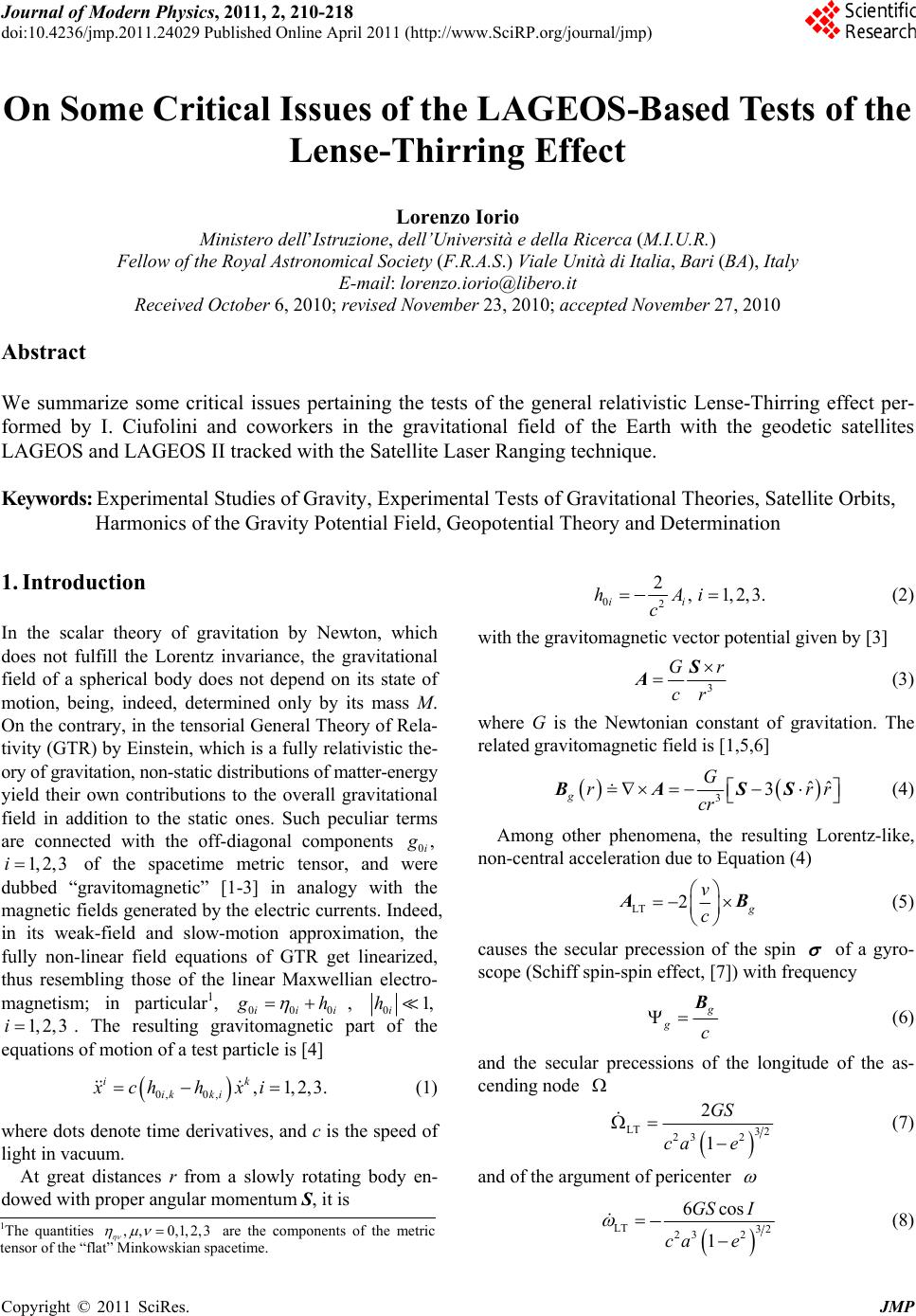 Journal of Modern Physics, 2011, 2, 210-218 doi:10.4236/jmp.2011.24029 Published Online April 2011 (http://www.SciRP.org/journal/jmp) Copyright © 2011 SciRes. JMP On Some Critical Issues of the LAGEOS-Based Tests of the Lense-Thirring Effect Lorenzo Iorio Ministero dell’Istruzione, dell’Università e della Ricerca (M.I.U.R.) Fellow of the Royal Astronomical Society (F.R.A.S.) Viale Unità di Italia, Bari (BA), Italy E-mail: lorenzo.iorio@libero.it Received October 6, 2010; revised November 23, 2010; accepted November 27, 2010 Abstract We summarize some critical issues pertaining the tests of the general relativistic Lense-Thirring effect per- formed by I. Ciufolini and coworkers in the gravitational field of the Earth with the geodetic satellites LAGEOS and LAGEOS II tracked with the Satellite Laser Ranging technique. Keywords: Experimental Studies of Gravity, Experimental Tests of Gravitational Theories, Satellite Orbits, Harmonics of the Gravity Potential Field, Geopotential Theory and Determination 1. Introduction In the scalar theory of gravitation by Newton, which does not fulfill the Lorentz invariance, the gravitational field of a spherical body does not depend on its state of motion, being, indeed, determined only by its mass M. On the contrary, in the tensorial General Theory of Rela- tivity (GTR) by Einstein, which is a fully relativistic the- ory of gravitation, non-static distributions of matter-energy yield their own contributions to the overall gravitational field in addition to the static ones. Such peculiar terms are connected with the off-diagonal components 0, i of the spacetime metric tensor, and were dubbed “gravitomagnetic” [1-3] in analogy with the magnetic fields generated by the electric currents. Indeed, in its weak-field and slow-motion approximation, the fully non-linear field equations of GTR get linearized, thus resembling those of the linear Maxwellian electro- magnetism; in particular1, 000iii 1,2, 3i h , 01, i . The resulting gravitomagnetic part of the equations of motion of a test particle is [4] h . 1,2, 3i 0,0 ,,1,2,3 ik ik ki xchh xi (1) where dots denote time derivatives, and c is the speed of light in vacuum. At great distances r from a slowly rotating body en- dowed with proper angular momentum S, it is 02 2,1,2,3 ii hAi c . (2) with the gravitomagnetic vector potential given by [3] 3 G cr S Ar (3) where G is the Newtonian constant of gravitation. The related gravitomagnetic field is [1,5,6] 3ˆˆ 3 g G rr cr BASSr (4) Among other phenomena, the resulting Lorentz-like, non-central acceleration due to Equation (4) LT 2 v c AB (5) causes the secular precession of the spin of a gyro- scope (Schiff spin-spin effect, [7]) with frequency gc B (6) and the secular precessions of the longitude of the as- cending node LT 32 23 2 2 1 GS ca e (7) and of the argument of pericenter LT 32 23 2 6cos 1 GS I ca e (8) 1The quantities are the components of the metric ,,0,1, 2, 3 tensor of the “flat” Minkowskian spacetime. 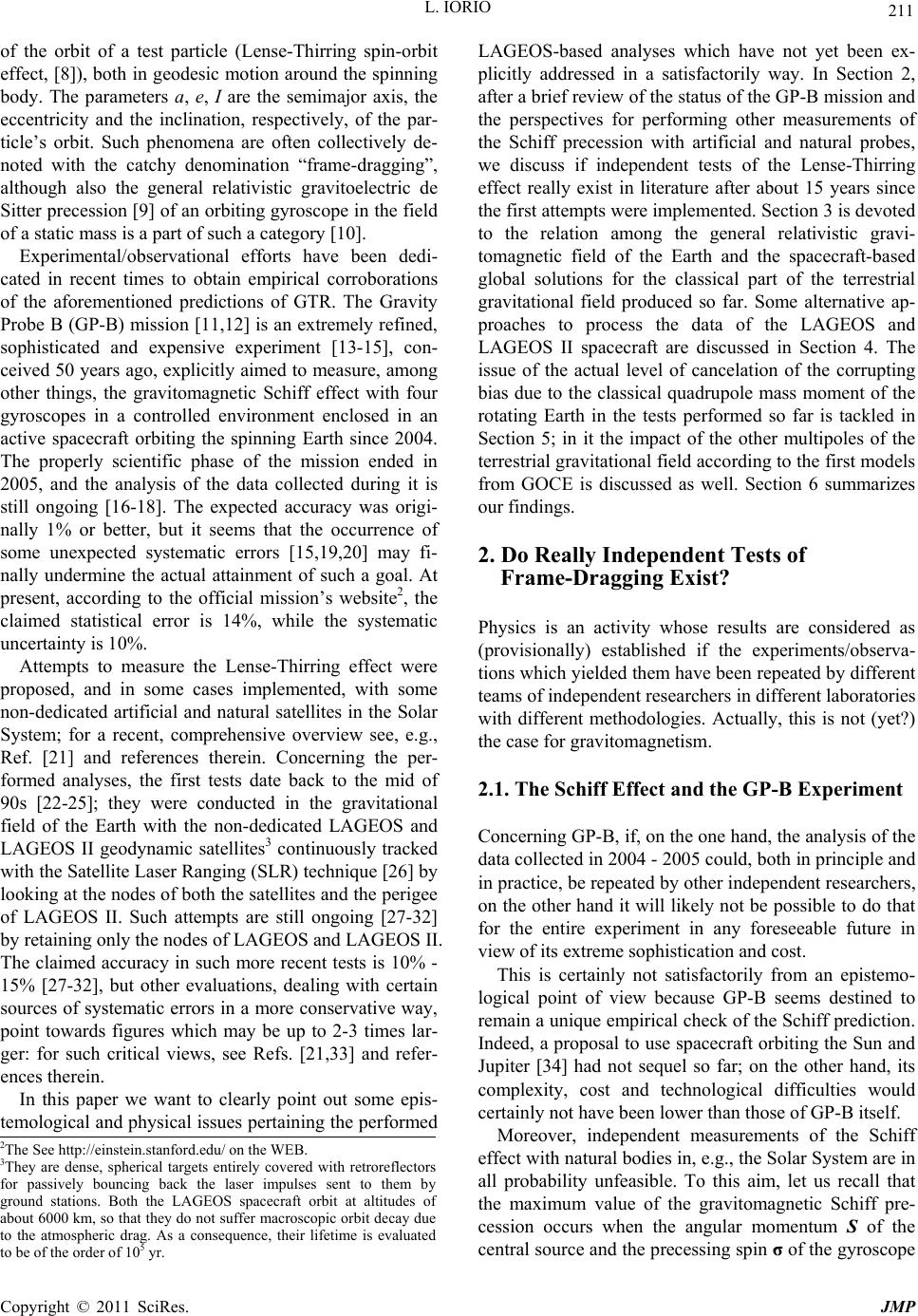 L. IORIO 211 of the orbit of a test particle (Lense-Th effect, [8]), both in geodesic motion ar body. The parameters a, e, I are the semimajor axis, the Gravity Pr ial and natural satellites in the Solar Sy d analyses which have not yet been ex- pl ragging Exist? onsidered as (pr experiments/observa- ons which yielded them have been repeated by different oncerning GP-B, if, on the one hand, the analysis of the practice, be repeated by other independent researchers, ff prediction. In t th irring spin-orbit ound the spinning eccentricity and the inclination, respectively, of the par- ticle’s orbit. Such phenomena are often collectively de- noted with the catchy denomination “frame-dragging”, although also the general relativistic gravitoelectric de Sitter precession [9] of an orbiting gyroscope in the field of a static mass is a part of such a category [10]. Experimental/observational efforts have been dedi- cated in recent times to obtain empirical corroborations of the aforementioned predictions of GTR. The obe B (GP-B) mission [11,12] is an extremely refined, sophisticated and expensive experiment [13-15], con- ceived 50 years ago, explicitly aimed to measure, among other things, the gravitomagnetic Schiff effect with four gyroscopes in a controlled environment enclosed in an active spacecraft orbiting the spinning Earth since 2004. The properly scientific phase of the mission ended in 2005, and the analysis of the data collected during it is still ongoing [16-18]. The expected accuracy was origi- nally 1% or better, but it seems that the occurrence of some unexpected systematic errors [15,19,20] may fi- nally undermine the actual attainment of such a goal. At present, according to the official mission’s website2, the claimed statistical error is 14%, while the systematic uncertainty is 10%. Attempts to measure the Lense-Thirring effect were proposed, and in some cases implemented, with some non-dedicated artific stem; for a recent, comprehensive overview see, e.g., Ref. [21] and references therein. Concerning the per- formed analyses, the first tests date back to the mid of 90s [22-25]; they were conducted in the gravitational field of the Earth with the non-dedicated LAGEOS and LAGEOS II geodynamic satellites3 continuously tracked with the Satellite Laser Ranging (SLR) technique [26] by looking at the nodes of both the satellites and the perigee of LAGEOS II. Such attempts are still ongoing [27-32] by retaining only the nodes of LAGEOS and LAGEOS II. The claimed accuracy in such more recent tests is 10% - 15% [27-32], but other evaluations, dealing with certain sources of systematic errors in a more conservative way, point towards figures which may be up to 2-3 times lar- ger: for such critical views, see Refs. [21,33] and refer- ences therein. In this paper we want to clearly point out some epis- temological and physical issues pertaining the performed LAGEOS-base icitly addressed in a satisfactorily way. In Section 2, after a brief review of the status of the GP-B mission and the perspectives for performing other measurements of the Schiff precession with artificial and natural probes, we discuss if independent tests of the Lense-Thirring effect really exist in literature after about 15 years since the first attempts were implemented. Section 3 is devoted to the relation among the general relativistic gravi- tomagnetic field of the Earth and the spacecraft-based global solutions for the classical part of the terrestrial gravitational field produced so far. Some alternative ap- proaches to process the data of the LAGEOS and LAGEOS II spacecraft are discussed in Section 4. The issue of the actual level of cancelation of the corrupting bias due to the classical quadrupole mass moment of the rotating Earth in the tests performed so far is tackled in Section 5; in it the impact of the other multipoles of the terrestrial gravitational field according to the first models from GOCE is discussed as well. Section 6 summarizes our findings. 2. Do Really Independent Tests of Frame-D Physics is an activity whose results are c ovisionally) established if the ti teams of independent researchers in different laboratories with different methodologies. Actually, this is not (yet?) the case for gravitomagnetism. 2.1. The Schiff Effect and the GP-B Experiment C data collected in 2004 - 2005 could, both in principle and in on the other hand it will likely not be possible to do that for the entire experiment in any foreseeable future in view of its extreme sophistication and cost. This is certainly not satisfactorily from an epistemo- logical point of view because GP-B seems destined to remain a unique empirical check of the Schi deed, a proposal to use spacecraft orbiting the Sun and Jupiter [34] had not sequel so far; on the other hand, its complexity, cost and technological difficulties would certainly not have been lower than those of GP-B itself. Moreover, independent measurements of the Schiff effect with natural bodies in, e.g., the Solar System are in all probability unfeasible. To this aim, let us recall tha 2The See http://einstein.stanford.edu/ on the WEB. 3They are dense, spherical targets entirely covered with retroreflectors for passively bouncing back the laser impulses sent to them by ground stations. Both the LAGEOS spacecraft orbit at altitudes o about 6000 km, so that they do not suffer macroscopic orbit decay due to the atmospheric drag. As a consequence, their lifetime is evaluated to be of the order of 105 yr. e maximum value of the gravitomagnetic Schiff pre- cession occurs when the angular momentum S of the central source and the precessing spin σ of the gyroscope Copyright © 2011 SciRes. JMP 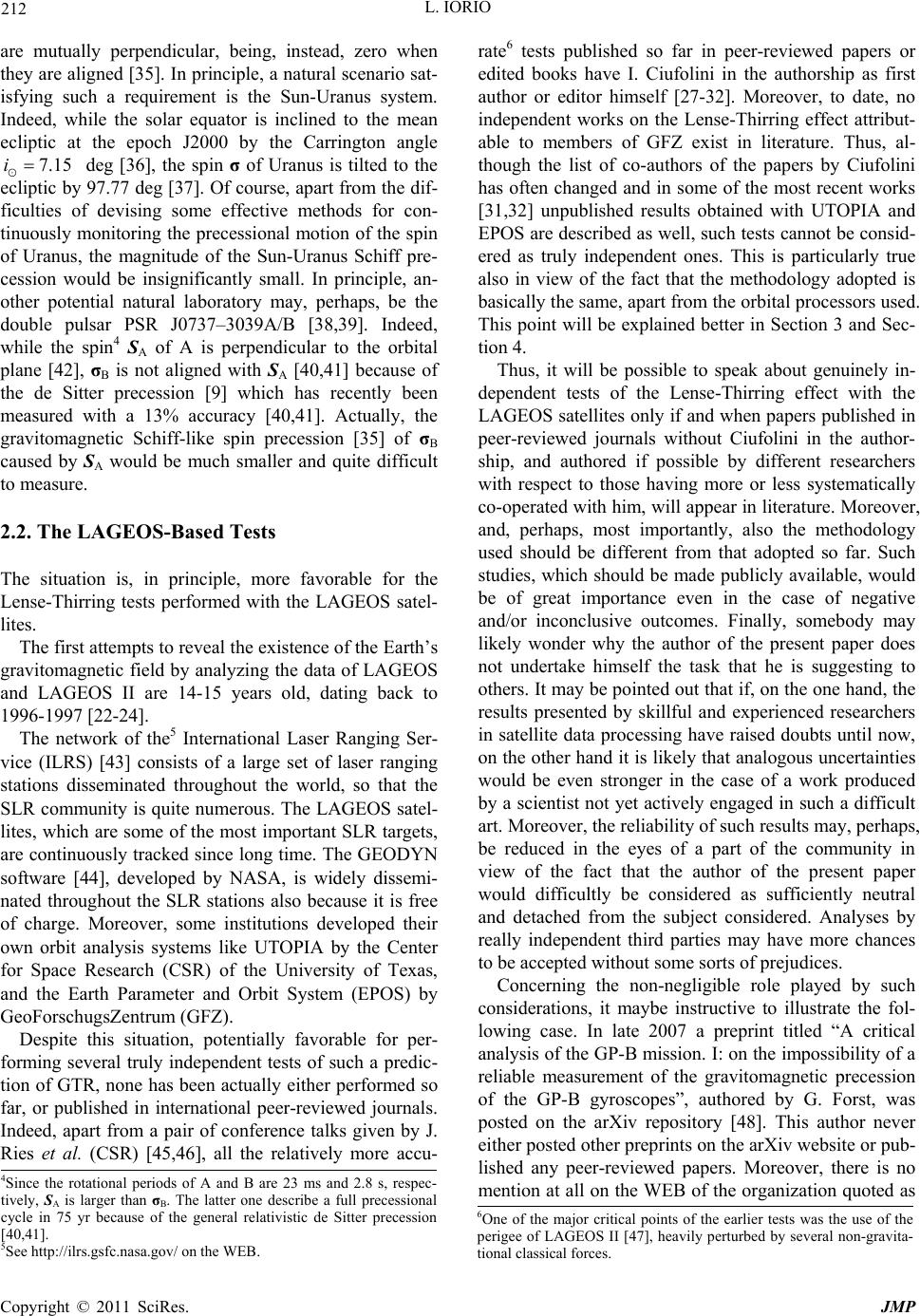 L. IORIO 212 tinuously he situation is, in principle, more favorable for the the LAGEOS satel- tes. AGEOS II are 14-15 years old, dating back to 19 throughout the world, so that the SL either performed so fa S satellites only if and when papers published in pe critical an are mutually perpendicular, being, instead, zero when they are aligned [35]. In principle, a natural scenario sat- isfying such a requirement is the Sun-Uranus system. Indeed, while the solar equator is inclined to the mean ecliptic at the epoch J2000 by the Carrington angle 7.15i deg [36], the spin σ of Uranus is tilted to the ecliptic by 97.77 deg [37]. Of course, apart from the dif- ficulties of devising some effective methods for con- monitoring the precessional motion of the spin of Uranus, the magnitude of the Sun-Uranus Schiff pre- cession would be insignificantly small. In principle, an- other potential natural laboratory may, perhaps, be the double pulsar PSR J0737–3039A/B [38,39]. Indeed, while the spin4 SA of A is perpendicular to the orbital plane [42], σB is not aligned with SA [40,41] because of the de Sitter precession [9] which has recently been measured with a 13% accuracy [40,41]. Actually, the gravitomagnetic Schiff-like spin precession [35] of σB caused by SA would be much smaller and quite difficult to measure. 2.2. The LAGEOS-Based Tests T Lense-Thirring tests performed with li The first attempts to reveal the existence of the Earth’s gravitomagnetic field by analyzing the data of LAGEOS and L 96-1997 [22-24]. The network of the5 International Laser Ranging Ser- vice (ILRS) [43] consists of a large set of laser ranging stations disseminated R community is quite numerous. The LAGEOS satel- lites, which are some of the most important SLR targets, are continuously tracked since long time. The GEODYN software [44], developed by NASA, is widely dissemi- nated throughout the SLR stations also because it is free of charge. Moreover, some institutions developed their own orbit analysis systems like UTOPIA by the Center for Space Research (CSR) of the University of Texas, and the Earth Parameter and Orbit System (EPOS) by GeoForschugsZentrum (GFZ). Despite this situation, potentially favorable for per- forming several truly independent tests of such a predic- tion of GTR, none has been actually r, or published in international peer-reviewed journals. Indeed, apart from a pair of conference talks given by J. Ries et al. (CSR) [45,46], all the relatively more accu- rate6 tests published so far in peer-reviewed papers or edited books have I. Ciufolini in the authorship as first author or editor himself [27-32]. Moreover, to date, no independent works on the Lense-Thirring effect attribut- able to members of GFZ exist in literature. Thus, al- though the list of co-authors of the papers by Ciufolini has often changed and in some of the most recent works [31,32] unpublished results obtained with UTOPIA and EPOS are described as well, such tests cannot be consid- ered as truly independent ones. This is particularly true also in view of the fact that the methodology adopted is basically the same, apart from the orbital processors used. This point will be explained better in Section 3 and Sec- tion 4. Thus, it will be possible to speak about genuinely in- dependent tests of the Lense-Thirring effect with the LAGEO er-reviewed journals without Ciufolini in the author- ship, and authored if possible by different researchers with respect to those having more or less systematically co-operated with him, will appear in literature. Moreover, and, perhaps, most importantly, also the methodology used should be different from that adopted so far. Such studies, which should be made publicly available, would be of great importance even in the case of negative and/or inconclusive outcomes. Finally, somebody may likely wonder why the author of the present paper does not undertake himself the task that he is suggesting to others. It may be pointed out that if, on the one hand, the results presented by skillful and experienced researchers in satellite data processing have raised doubts until now, on the other hand it is likely that analogous uncertainties would be even stronger in the case of a work produced by a scientist not yet actively engaged in such a difficult art. Moreover, the reliability of such results may, perhaps, be reduced in the eyes of a part of the community in view of the fact that the author of the present paper would difficultly be considered as sufficiently neutral and detached from the subject considered. Analyses by really independent third parties may have more chances to be accepted without some sorts of prejudices. Concerning the non-negligible role played by such considerations, it maybe instructive to illustrate the fol- lowing case. In late 2007 a preprint titled “A alysis of the GP-B mission. I: on the impossibility of a reliable measurement of the gravitomagnetic precession of the GP-B gyroscopes”, authored by G. Forst, was posted on the arXiv repository [48]. This author never either posted other preprints on the arXiv website or pub- lished any peer-reviewed papers. Moreover, there is no mention at all on the WEB of the organization quoted as 4Since the rotational periods of A and B are 23 ms and 2.8 s, respec- tively, SA is larger than σB. The latter one describe a full precessional cycle in 75 yr because of the general relativistic de Sitter precession [40,41]. 5See http://ilrs.gsfc.nasa.gov/ on the WEB. 6One of the major critical points of the earlier tests was the use of the erigee of LAGEOS II [47], heavily perturbed by several non-gravita- tional classical forces. Copyright © 2011 SciRes. JMP 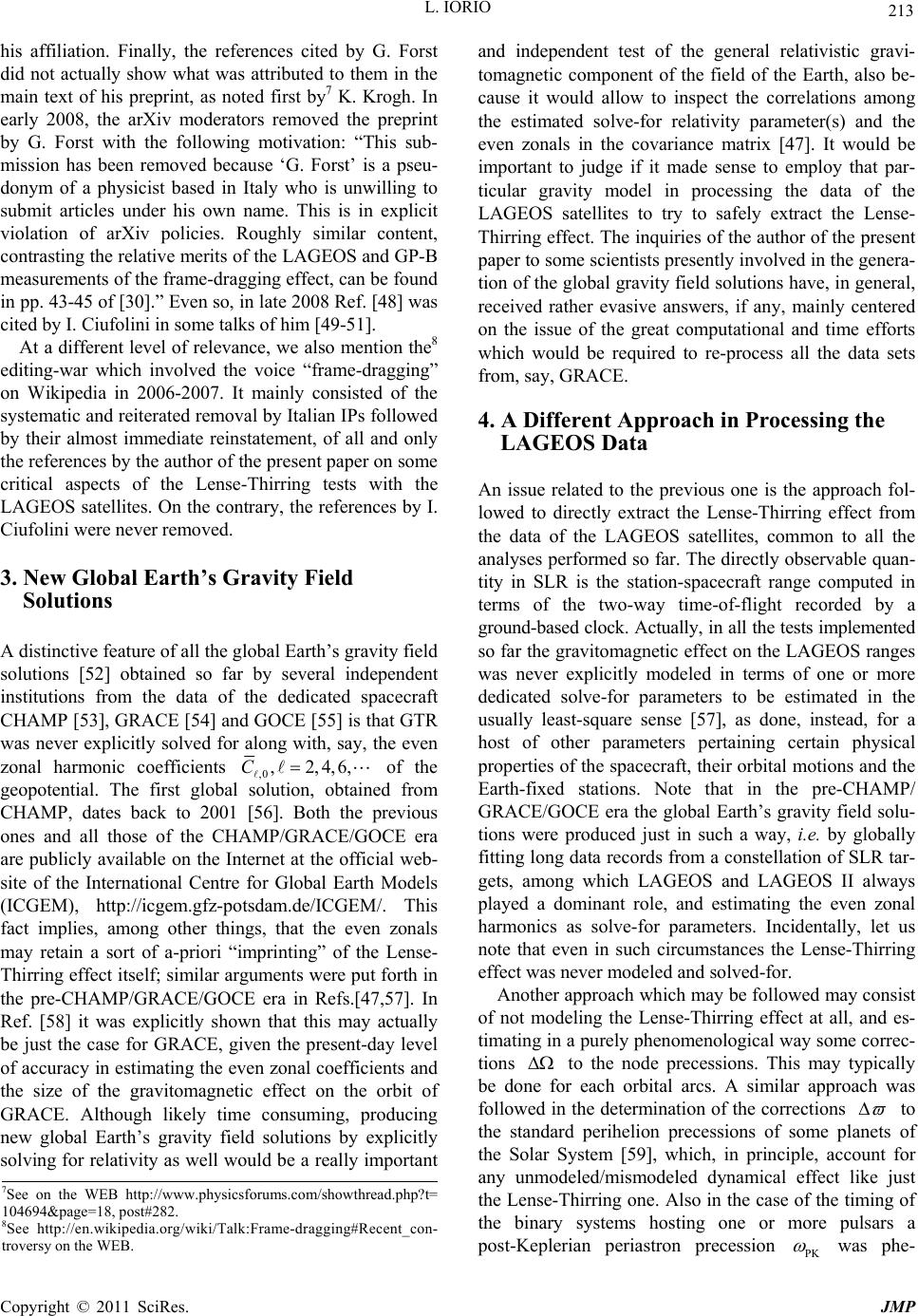 L. IORIO 213 the sy ity field sobtained so far by several independent stitutions from the data of the dedicated spacecraft his affiliation. Finally, the references cited by G. Forst did not actually show what was attributed to them in the main text of his preprint, as noted first by7 K. Krogh. In early 2008, the arXiv moderators removed the preprint by G. Forst with the following motivation: “This sub- mission has been removed because ‘G. Forst’ is a pseu- donym of a physicist based in Italy who is unwilling to submit articles under his own name. This is in explicit violation of arXiv policies. Roughly similar content, contrasting the relative merits of the LAGEOS and GP-B measurements of the frame-dragging effect, can be found in pp. 43-45 of [30].” Even so, in late 2008 Ref. [48] was cited by I. Ciufolini in some talks of him [49-51]. At a different level of relevance, we also mention the8 editing-war which involved the voice “frame-dragging” on Wikipedia in 2006-2007. It mainly consisted of stematic and reiterated removal by Italian IPs followed by their almost immediate reinstatement, of all and only the references by the author of the present paper on some critical aspects of the Lense-Thirring tests with the LAGEOS satellites. On the contrary, the references by I. Ciufolini were never removed. 3. New Global Earth’s Gravity Field Solutions A distinctive feature of all the global Earth’s grav lutions [52] o in CHAMP [53], GRACE [54] and GOCE [55] is that GTR was never explicitly solved for along with, say, the even zonal harmonic coefficients ,0 ,2,4,6,C of the geopotential. The first global solution, obtained from CHAMP, dates back to 2001 [56]. Both the previous ones and all those of the CHACE era are publicly available on the Internet at the official web- site of the International Centre for Global Earth Models (ICGEM), http://icgem.gfz-potsdam.de/ICGEM/. This fact implies, among other things, that the even zonals may retain a sort of a-priori “imprinting” of the Lense- Thirring effect itself; similar arguments were put forth in the pre-CHAMP/GRACE/GOCE era in Refs.[47,57]. In Ref. [58] it was explicitly shown that this may actually be just the case for GRACE, given the present-day level of accuracy in estimating the even zonal coefficients and the size of the gravitomagnetic effect on the orbit of GRACE. Although likely time consuming, producing new global Earth’s gravity field solutions by explicitly solving for relativity as well would be a really important and independent test of the general relativistic gravi- tomagnetic component of the field of the Earth, also be- cause it would allow to inspect the correlations among the estimated solve-for relativity parameter(s) and the even zonals in the covariance matrix [47]. It would be important to judge if it made sense to employ that par- ticular gravity model in processing the data of the LAGEOS satellites to try to safely extract the Lense- Thirring effect. The inquiries of the author of the present paper to some scientists presently involved in the genera- tion of the global gravity field solutions have, in general, received rather evasive answers, if any, mainly centered on the issue of the great computational and time efforts which would be required to re-process all the data sets from, say, GRACE. 4. A Different Approach in Processing the LAGEOS Data MP/GRACE/GO ol- lowt the Lense-Thirring effect from e data of the LAGEOS satellites, common to all the y some correc- tio An issue related to the previous one is the approach f ed to directly extrac th analyses performed so far. The directly observable quan- tity in SLR is the station-spacecraft range computed in terms of the two-way time-of-flight recorded by a ground-based clock. Actually, in all the tests implemented so far the gravitomagnetic effect on the LAGEOS ranges was never explicitly modeled in terms of one or more dedicated solve-for parameters to be estimated in the usually least-square sense [57], as done, instead, for a host of other parameters pertaining certain physical properties of the spacecraft, their orbital motions and the Earth-fixed stations. Note that in the pre-CHAMP/ GRACE/GOCE era the global Earth’s gravity field solu- tions were produced just in such a way, i.e. by globally fitting long data records from a constellation of SLR tar- gets, among which LAGEOS and LAGEOS II always played a dominant role, and estimating the even zonal harmonics as solve-for parameters. Incidentally, let us note that even in such circumstances the Lense-Thirring effect was never modeled and solved-for. Another approach which may be followed may consist of not modeling the Lense-Thirring effect at all, and es- timating in a purely phenomenological wa ns to the node precessions. This may typically be done for each orbital arcs. A similar approach was followed in the determination of the corrections to the stard perihelion precessions of some planets of the Solar System [59], which, in principle, account for any unmodeled/mismodeled dynamical effect ljust the Lense-Thirring one. Also in the case of the timing of the binary systems hosting one or more pulsars a post-Keplerian periastron precession PK nda ike was phe- 7See on the WEB http://www.physicsforums.com/showthread.php?t= 104694&page=18, post#282. 8See http://en.wikipedia.org/wiki/Talk:Frame-dragging#Recent_con- troversy on the WEB. Copyright © 2011 SciRes. JMP 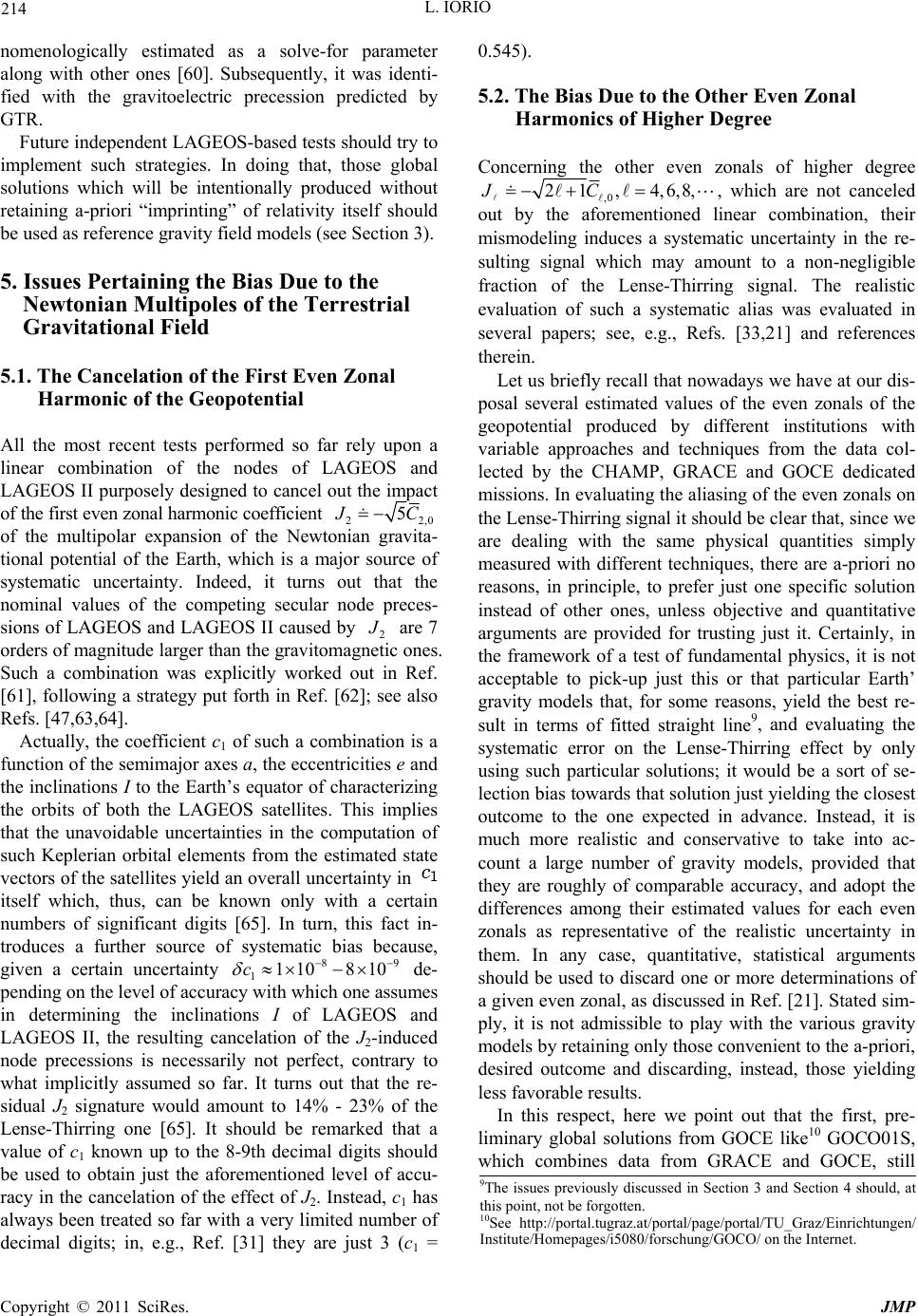 L. IORIO 214 n p ns which will be intentionally produced without re Gravitational Field 5.1 potential n a lineaLAGEOS and AGEOS II purposely designed to cancel out the impact nomenologically estimated as a solve-for parameter along with other ones [60]. Subsequently, it was identi- fied with the gravitoelectric precessioredicted by GTR. Future independent LAGEOS-based tests should try to implement such strategies. In doing that, those global solutio taining a-priori “imprinting” of relativity itself should be used as reference gravity field models (see Section 3). 5. Issues Pertaining the Bias Due to the Newtonian Multipoles of the Terrestrial . The Cancelation of the First Even Zonal Harmonic of the Geo All the most recent tests performed so far rely upo r combination of the nodes of L of the first even zonal harmonic coefficient 22,0 5 C of the multipolar expansion of the Newtonian gravita- tional potential of the Earth, which is a major source of systematic uncertainty. Indeed, it turns nominal values of the competing secular node preces- sions of LAGEOS and LAGEOS II caused by 2 out that the are 7 orders of magnitude larger than the gravitomagnetic ones. Such a combination was explicitly worked out in Ref. [61], following a strategy put forth in Ref. [62]ee also Refs. [47,63,64]. Actually, the coefficient c1 of such a combination is a function of the semimajor axes a, the eccentricities e and the inclinations I t ; s o the Earth’s equator of characterizing the orbits of both the LAGEOS satellites. This implies that the unavoidable uncertainties in the computation of such Keplerian orbital elements from the estimated state vectors of the satellites yield an overall uncertainty in itself which, thus, can be known only with a certain numbers of significant digits [65]. In turn, this fact in- troduces a further source of systematic bias becaus, given a certain uncertainty 89 1110 810c de- pending on the level of accuracy with which one assumes in determining the inclinations I of LAGEOS and LAGEOS II, the resulting can2uced node precessions is necessarily not perfect, contrary to what implicitly assumed so far. It turns out that the re- sidual J2 signature would amount to 14% - 23% of the Lense-Thirring one [65]. It should be remarked that a value of c1 known up to the 8-9th decimal digits should be used to obtain just the aforementioned level of accu- racy in the cancelation of the effect of J2. Instead, c1 has always been treated so far with a very limited number of decimal digits; in, e.g., Ref. [31] they are just 3 (c1 = 0.545). 5.2. The Bias Due to the Other Even Zonal Ha e celation of the J-ind rmonics of Higher Degree egree Concerning the other even zonals of higher d ,0 21 ,4,6,8,C , which J are not canceled ut by the aforementioned linear combination, their sulting signal which may am tial produced by different institutions with va from GRACE and GOCE, still o mismodeling induces a systematic uncertainty in the re- ount to a non-negligible fraction of the Lense-Thirring signal. The realistic evaluation of such a systematic alias was evaluated in several papers; see, e.g., Refs. [33,21] and references therein. Let us briefly recall that nowadays we have at our dis- posal several estimated values of the even zonals of the geopoten riable approaches and techniques from the data col- lected by the CHAMP, GRACE and GOCE dedicated missions. In evaluating the aliasing of the even zonals on the Lense-Thirring signal it should be clear that, since we are dealing with the same physical quantities simply measured with different techniques, there are a-priori no reasons, in principle, to prefer just one specific solution instead of other ones, unless objective and quantitative arguments are provided for trusting just it. Certainly, in the framework of a test of fundamental physics, it is not acceptable to pick-up just this or that particular Earth’ gravity models that, for some reasons, yield the best re- sult in terms of fitted straight line9, and evaluating the systematic error on the Lense-Thirring effect by only using such particular solutions; it would be a sort of se- lection bias towards that solution just yielding the closest outcome to the one expected in advance. Instead, it is much more realistic and conservative to take into ac- count a large number of gravity models, provided that they are roughly of comparable accuracy, and adopt the differences among their estimated values for each even zonals as representative of the realistic uncertainty in them. In any case, quantitative, statistical arguments should be used to discard one or more determinations of a given even zonal, as discussed in Ref. [21]. Stated sim- ply, it is not admissible to play with the various gravity models by retaining only those convenient to the a-priori, desired outcome and discarding, instead, those yielding less favorable results. In this respect, here we point out that the first, pre- liminary global solutions from GOCE like10 GOCO01S, which combines data 9The issues previously discussed in Section 3 and Section 4 should, at this point, not be forgotten. 10See http://portal.tugraz.at/portal/page/portal/TU_Graz/Einrichtungen/ Institute/Homepages/i5080/forschung/GOCO/ on the Internet. Copyright © 2011 SciRes. JMP 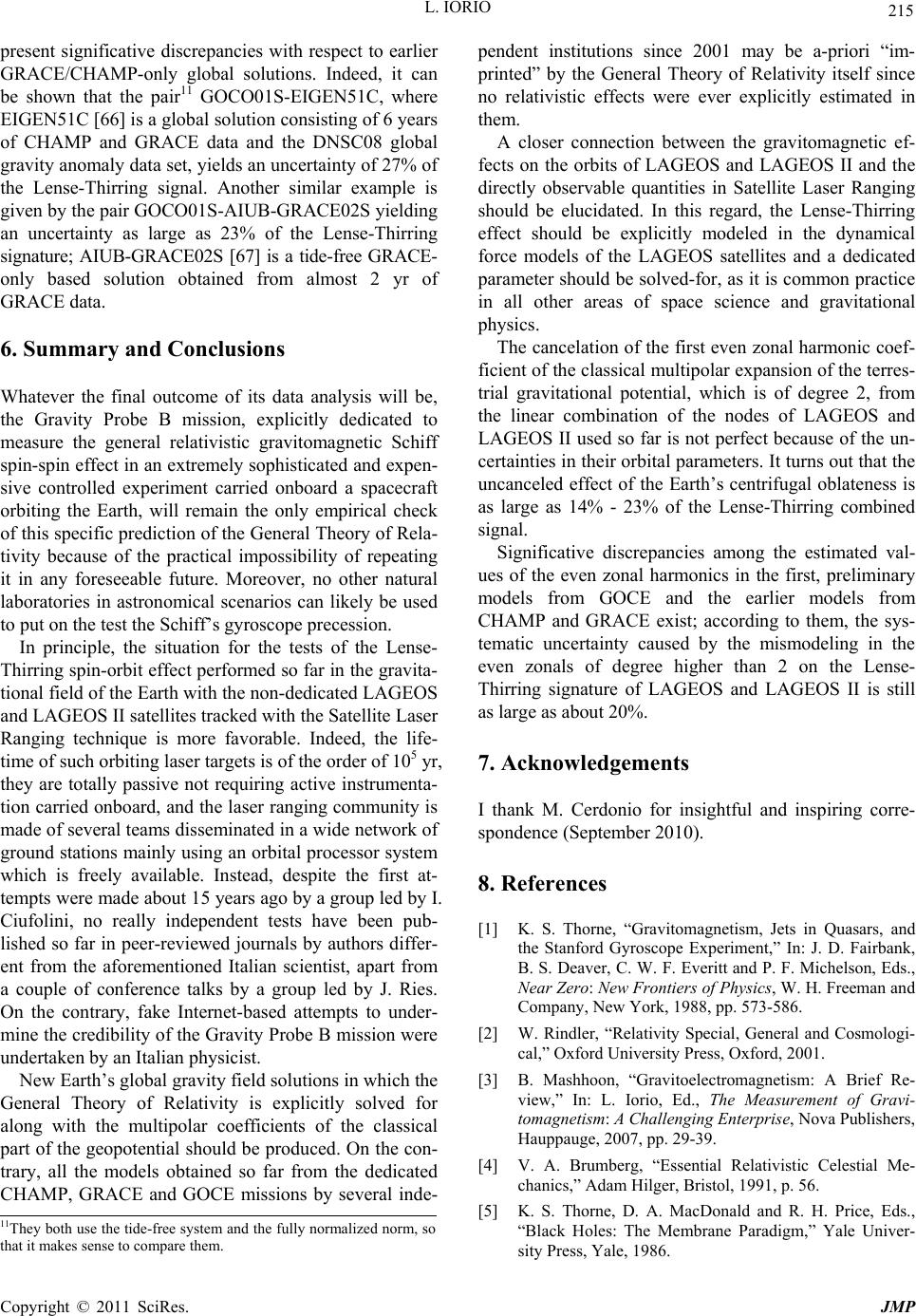 L. IORIO 215 pr hatever the final outcome of its data analysis will be, citly dedicated to easure the general relativistic gravitomagnetic Schiff EOS an ients of the classical pa observable quantities in Satellite Laser Ranging sh itational potential, which is of degree 2, from th from GOCE and the earlier models from CH ank M. Cerdonio for insightful and inspiring corre- ] K. S. Thorne, “Gravitomagnetism, Jets in Quasars, and yroscope Experiment,” In: J. D. Fairbank, veritt and P. F. Michelson, Eds., A Brief Re- Publishers, ald and R. H. Price, Eds., sity Press, Yale, 1986. esent significative discrepancies with respect to earlier GRACE/CHAMP-only global solutions. Indeed, it can be shown that the pair11 GOCO01S-EIGEN51C, where EIGEN51C [66] is a global solution consisting of 6 years of CHAMP and GRACE data and the DNSC08 global gravity anomaly data set, yields an uncertainty of 27% of the Lense-Thirring signal. Another similar example is given by the pair GOCO01S-AIUB-GRACE02S yielding an uncertainty as large as 23% of the Lense-Thirring signature; AIUB-GRACE02S [67] is a tide-free GRACE- only based solution obtained from almost 2 yr of GRACE data. 6. Summary and Conclusions W the Gravity Probe B mission, expli m spin-spin effect in an extremely sophisticated and expen- sive controlled experiment carried onboard a spacecraft orbiting the Earth, will remain the only empirical check of this specific prediction of the General Theory of Rela- tivity because of the practical impossibility of repeating it in any foreseeable future. Moreover, no other natural laboratories in astronomical scenarios can likely be used to put on the test the Schiff’s gyroscope precession. In principle, the situation for the tests of the Lense- Thirring spin-orbit effect performed so far in the gravita- tional field of the Earth with the non-dedicated LAG d LAGEOS II satellites tracked with the Satellite Laser Ranging technique is more favorable. Indeed, the life- time of such orbiting laser targets is of the order of 105 yr, they are totally passive not requiring active instrumenta- tion carried onboard, and the laser ranging community is made of several teams disseminated in a wide network of ground stations mainly using an orbital processor system which is freely available. Instead, despite the first at- tempts were made about 15 years ago by a group led by I. Ciufolini, no really independent tests have been pub- lished so far in peer-reviewed journals by authors differ- ent from the aforementioned Italian scientist, apart from a couple of conference talks by a group led by J. Ries. On the contrary, fake Internet-based attempts to under- mine the credibility of the Gravity Probe B mission were undertaken by an Italian physicist. New Earth’s global gravity field solutions in which the General Theory of Relativity is explicitly solved for along with the multipolar coeffic vie rt of the geopotential should be produced. On the con- trary, all the models obtained so far from the dedicated CHAMP, GRACE and GOCE missions by several inde- pendent institutions since 2001 may be a-priori “im- printed” by the General Theory of Relativity itself since no relativistic effects were ever explicitly estimated in them. A closer connection between the gravitomagnetic ef- fects on the orbits of LAGEOS and LAGEOS II and the directly ould be elucidated. In this regard, the Lense-Thirring effect should be explicitly modeled in the dynamical force models of the LAGEOS satellites and a dedicated parameter should be solved-for, as it is common practice in all other areas of space science and gravitational physics. The cancelation of the first even zonal harmonic coef- ficient of the classical multipolar expansion of the terres- trial grav e linear combination of the nodes of LAGEOS and LAGEOS II used so far is not perfect because of the un- certainties in their orbital parameters. It turns out that the uncanceled effect of the Earth’s centrifugal oblateness is as large as 14% - 23% of the Lense-Thirring combined signal. Significative discrepancies among the estimated val- ues of the even zonal harmonics in the first, preliminary models AMP and GRACE exist; according to them, the sys- tematic uncertainty caused by the mismodeling in the even zonals of degree higher than 2 on the Lense- Thirring signature of LAGEOS and LAGEOS II is still as large as about 20%. 7. Acknowledgements I th spondence (September 2010). 8. References [1 the Stanford G B. S. Deaver, C. W. F. E Near Zero: New Frontiers of Physics, W. H. Freeman and Company, New York, 1988, pp. 573-586. [2] W. Rindler, “Relativity Special, General and Cosmologi- cal,” Oxford University Press, Oxford, 2001. [3] B. Mashhoon, “Gravitoelectromagnetism: w,” In: L. Iorio, Ed., The Measurement of Gravi- tomagnetism: A Challenging Enterprise, Nova Hauppauge, 2007, pp. 29-39. [4] V. A. Brumberg, “Essential Relativistic Celestial Me- chanics,” Adam Hilger, Bristol, 1991, p. 56. [5] K. S. Thorne, D. A. MacDon 11They both use the tide-free system and the fully normalized norm, so that it makes sense to compare them. “Black Holes: The Membrane Paradigm,” Yale Univer- Copyright © 2011 SciRes. JMP 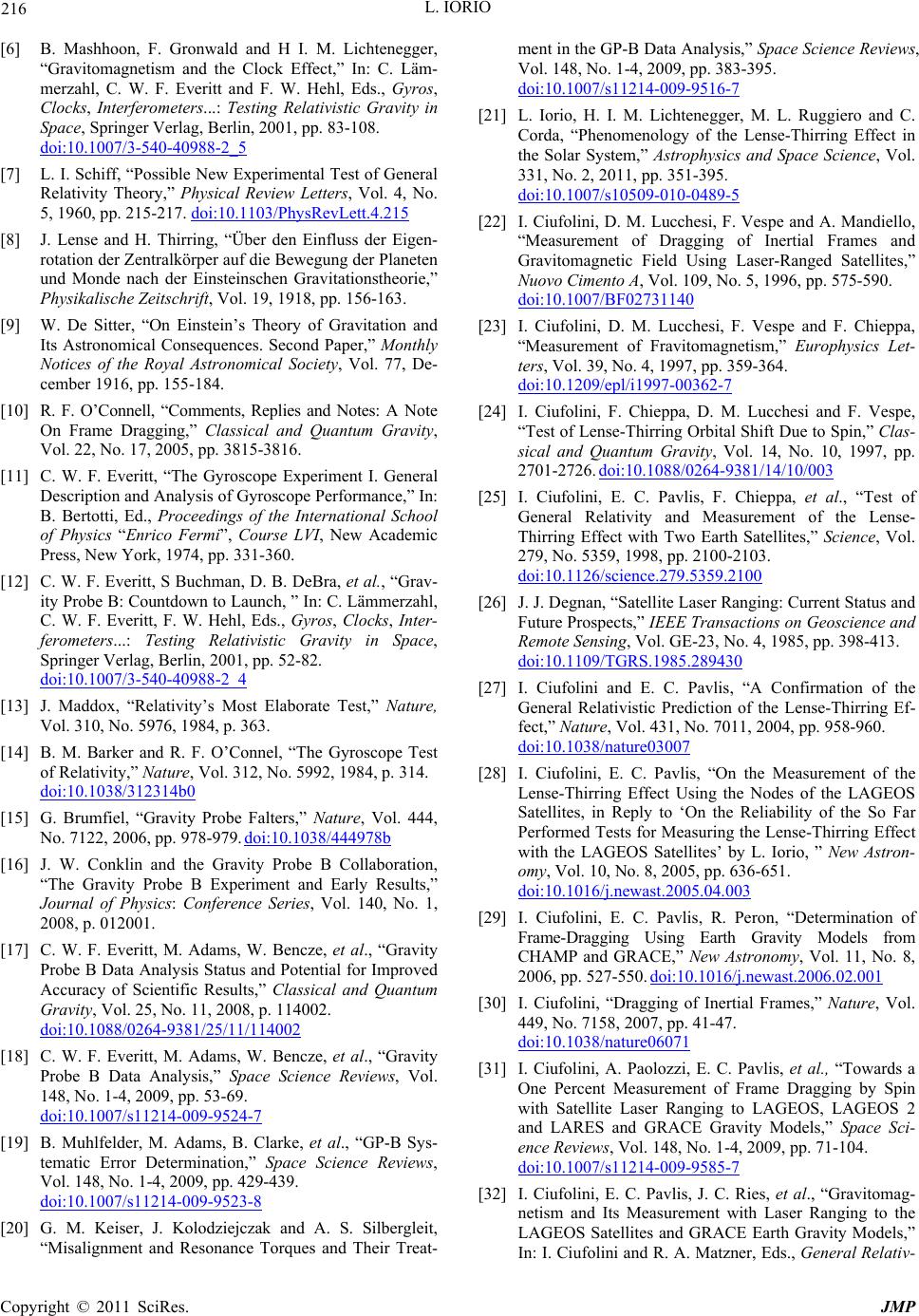 L. IORIO 216 tenegger, [6] B. Mashhoon, F. Gronwald and H I. M. Lich “Gravitomagnetism and the Clock Effect,” In: C. Läm- merzahl, C. W. F. Everitt and F. W. Hehl, Eds., Gyros, Clocks, Interferometers...: Testing Relativistic Gravity in Space, Springer Verlag, Berlin, 2001, pp. 83-108. doi:10.1007/3-540-40988-2_5 [7] L. I. Schiff, “Possible New Experimental Test of General Relativity Theory,” Physical Review Letters, Vol. 4, No. 5, 1960, pp. 215-217. doi:10.1103/PhysRevLett.4.215 [8] J. Lense and H. Thirring, “Über den Einfluss der Eigen- scope Experiment I. General rotation der Zentralkörper auf die Bewegung der Planeten und Monde nach der Einsteinschen Gravitationstheorie,” Physikalische Zeitschrift, Vol. 19, 1918, pp. 156-163. [9] W. De Sitter, “On Einstein’s Theory of Gravitation and Its Astronomical Consequences. Second Paper,” Monthly Notices of the Royal Astronomical Society, Vol. 77, De- cember 1916, pp. 155-184. [10] R. F. O’Connell, “Comments, Replies and Notes: A Note On Frame Dragging,” Classical and Quantum Gravity, Vol. 22, No. 17, 2005, pp. 3815-3816. [11] C. W. F. Everitt, “The Gyro Description and Analysis of Gyroscope Performance,” In: B. Bertotti, Ed., Proceedings of the International School of Physics “Enrico Fermi”, Course LVI, New Academic Press, New York, 1974, pp. 331-360. [12] C. W. F. Everitt, S Buchman, D. B. DeBra, et al., “Grav- ity Probe B: Countdown to Launch, ” In: C. Lämmerzahl, C. W. F. Everitt, F. W. Hehl, Eds., Gyros, Clocks, Inter- ferometers...: Testing Relativistic Gravity in Space, Springer Verlag, Berlin, 2001, pp. 52-82. doi:10.1007/3-540-40988-2_4 [13] J. Maddox, “Relativity’s Most Elaborate Test,” Nature, Vol. 310, No. 5976, 1984, p. 363. [14] B. M. Barker and R. F. O’Connel, “The G of Relativity,” Nature, Vol. 312 yroscope Test , No. 5992, 1984, p. 314. doi:10.1038/312314b0 [15] G. Brumfiel, “Gravity Probe Falters,” Nature, Vol. 444, No. 7122, 2006, pp. 978-979. doi:10.1038/444978b [16] J. W. Conklin and the Gravity Probe B Collaboration, “The Gravity Probe B ” Experiment and Early Results, Journal of Physics: Conference Series, Vol. 140, No. 1, 2008, p. 012001. [17] C. W. F. Everitt, M. Adams, W. Bencze, et al., “Gravity Probe B Data Analysis Status and Potential for Improved Accuracy of Scientific Results,” Classical and Quantum Gravity, Vol. 25, No. 11, 2008, p. 114002. doi:10.1088/0264-9381/25/11/114002 [18] C. W. F. Everitt, M. Adams, W. Bencze, et al., “Gravity Probe B Data Analysis,” Space Science Reviews, Vol. 148, No. 1-4, 2009, pp. 53-69. doi:10.1007/s11214-009-9524-7 [19] B. Muhlfelder, M. Adams, B. Clarke, et al., “GP-B Sys- tematic Error Determination,” Space Science Reviews, Vol. 148, No. 1-4, 2009, pp. 429-439. doi:10.1007/s11214-009-9523-8 [20] G. M. Keiser, J. Kolodziejczak and A. S. Silbergleit, “Misalignment and Resonance Torques and Their Treat- ment in the GP-B Data Analysis,” Space Science Reviews, Vol. 148, No. 1-4, 2009, pp. 383-395. doi:10.1007/s11214-009-9516-7 [21] L. Iorio, H. I. M. Lichtenegger, M. L. Ruggiero and C. Corda, “Phenomenology of the Lense-Thirring Effect in the Solar System,” Astrophysics and Space Science, Vol. 331, No. 2, 2011, pp. 351-395. doi:10.1007/s10509-010-0489-5 [22] I. Ciufolini, D. M. Lucchesi, F. Vespe and A. Mandiello, “Measurement of Dragging of Inertial Frames and Gravitomagnetic Field Using Laser-Ranged Satellites,” Nuovo Cimento A, Vol. 109, No. 5, 1996, pp. 575-590. doi:10.1007/BF02731140 [23] I. Ciufolini, D. M. Lucchesi, F. Vespe and F. Chieppa, “Measurement of Fravitomagnetism,” Europhysics Let- ters, Vol. 39, No. 4, 1997, pp. 359-364. doi:10.1209/epl/i1997-00362-7 [24] I. Ciufolini, F. Chieppa, D. M. Lucchesi and F. Vespe, 0/003 “Test of Lense-Thirring Orbital Shift Due to Spin,” Clas- sical and Quantum Gravity, Vol. 14, No. 10, 1997, pp. 2701-2726. doi:10.1088/0264-9381/14/1 hieppa, et al., “Test of [25] I. Ciufolini, E. C. Pavlis, F. C General Relativity and Measurement of the Lense- Thirring Effect with Two Earth Satellites,” Science, Vol. 279, No. 5359, 1998, pp. 2100-2103. doi:10.1126/science.279.5359.2100 [26] J. J. Degnan, “Satellite Laser Ranging: Current Status and Future Prospects,” IEEE Transactions on Geoscience and Remote Sensing, Vol. GE-23, No. 4, 1985, pp. 398-413. doi:10.1109/TGRS.1985.289430 [27] I. Ciufolini and E. C. Pavlis, “A Confirmation of the General Relativistic Prediction of the Lense-Thirring Ef- fect,” Nature, Vol. 431, No. 7011, 2004, pp. 958-960. doi:10.1038/nature03007 [28] I. Ciufolini, E. C. Pavlis, “On the Measurement of the ect y L. Iorio, ” New Astron- Lense-Thirring Effect Using the Nodes of the LAGEOS Satellites, in Reply to ‘On the Reliability of the So Far Performed Tests for Measuring the Lense-Thirring Eff with the LAGEOS Satellites’ b omy, Vol. 10, No. 8, 2005, pp. 636-651. doi:10.1016/j.newast.2005.04.003 [29] I. Ciufolini, E. C. Pavlis, R. Peron, “Determination of Frame-Dragging Using Earth Gravity Models from CHAMP and GRACE,” New Astronomy, Vol. 11, No. 8, 2006, pp. 527-550. doi:10.1016/j.newast.2006.02.001 Frames,” Nature, Vol. [30] I. Ciufolini, “Dragging of Inertial 449, No. 7158, 2007, pp. 41-47. doi:10.1038/nature06071 [31] I. Ciufolini, A. Paolozzi, E. C. Pavlis, et al., “Towards a One Percent Measurement of Frame Dragging by Spin ity Models,” Space Sci- o. 1-4, 2009, pp. 71-104. with Satellite Laser Ranging to LAGEOS, LAGEOS 2 and LARES and GRACE Grav ence Reviews, Vol. 148, N doi:10.1007/s11214-009-9585-7 [32] I. Ciufolini, E. C. Pavlis, J. C. Ries, et al., “Gravitomag- netism and Its Measurement with Laser Ranging to the LAGEOS Satellites and GRACE Earth Gravity Models,” In: I. Ciufolini and R. A. Matzner, Eds., General Relativ- Copyright © 2011 SciRes. JMP 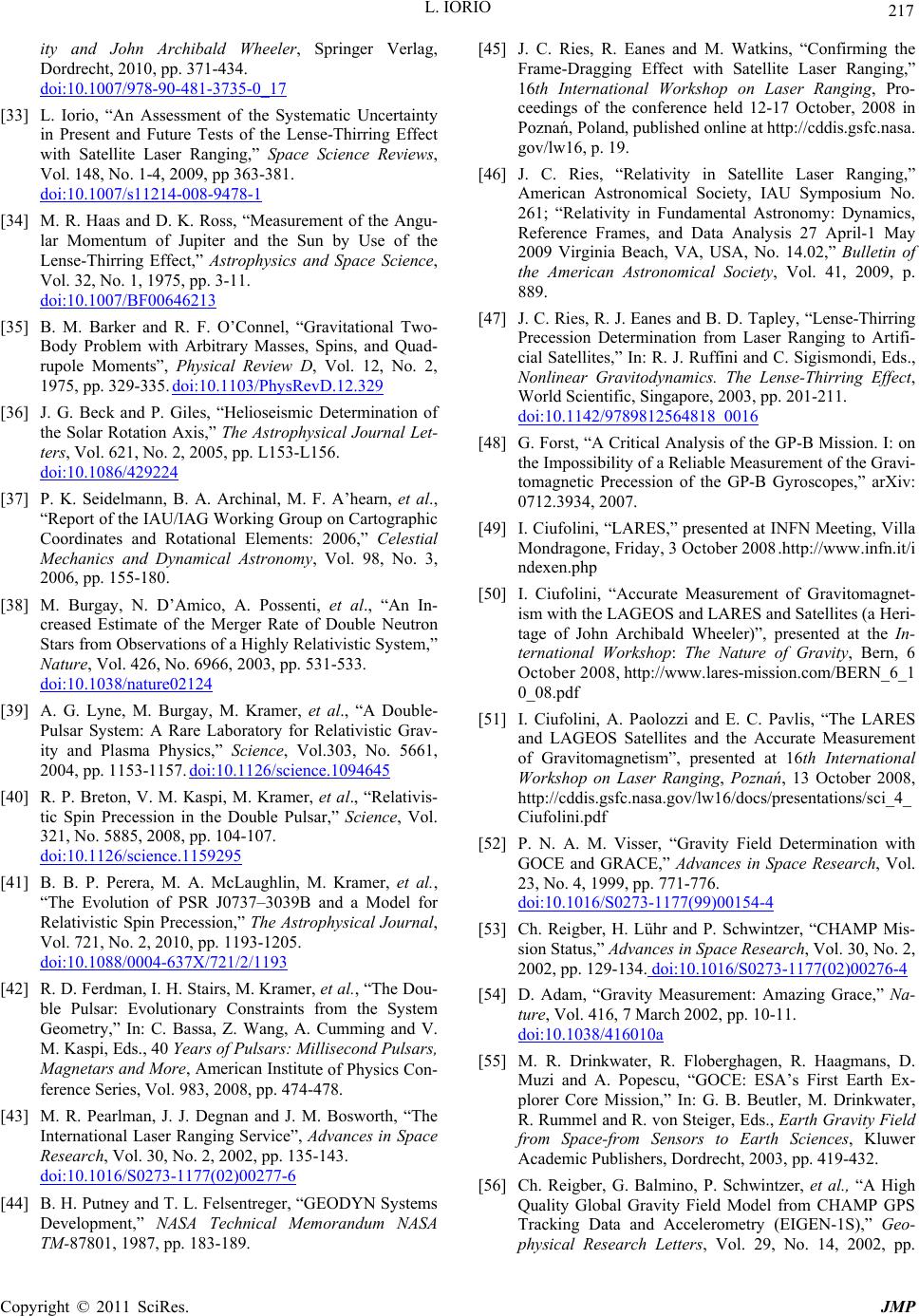 L. IORIO 217 erlag, ity and John Archibald Wheeler, Springer V Dordrecht, 2010, pp. 371-434. doi:10.1007/978-90-481-3735-0_17 [33] L. Iorio, “An Assessment of the Systematic Uncertainty in Present and Future Tests of the Lense-Thirring Effect with Satellite Laser Ranging,” Space Science Reviews, Vol. 148, No. 1-4, 2009, pp 363-381. doi:10.1007/s11214-008-9478-1 rement of the Angu-[34] M. R. Haas and D. K. Ross, “Measu lar Momentum of Jupiter and the Sun by Use of the Lense-Thirring Effect,” Astrophysics and Space Science, Vol. 32, No. 1, 1975, pp. 3-11. doi:10.1007/BF00646213 [35] B. M. Barker and R. F. O’Connel, “Gravitational Two- Body Problem with Arbitrary Masses, Spins, and Quad- rupole Moments”, Physical Review D, Vol. 12, No. 2, 1975, pp. 329-335. doi:10.1103/PhysRevD.12.329 [36] J. G. Beck and P. Giles, “Helio the Solar Rotation Axis,” T seismic Determination of he Astrophysical Journal Let- ters, Vol. 621, No. 2, 2005, pp. L153-L156. doi:10.1086/429224 [37] P. K. Seidelmann, B. A. Archinal, M. F. A’hearn, et al., “Report of the IAU/IAG Working Group on Cartographic mico, A. Possenti, et al., “An In- Coordinates and Rotational Elements: 2006,” Celestial Mechanics and Dynamical Astronomy, Vol. 98, No. 3, 2006, pp. 155-180. [38] M. Burgay, N. D’A creased Estimate of the Merger Rate of Double Neutron Stars from Observations of a Highly Relativistic System,” Nature, Vol. 426, No. 6966, 2003, pp. 531-533. doi:10.1038/nature02124 [39] A. G. Lyne, M. Burgay, M. Kramer, et al., “A Double- Pulsar System: A Rare Laboratory for Relativistic Grav- ity and Plasma Physics,” Science, Vol.303, No. 5661, 2004, pp. 1153-1157. doi:10.1126/science.1094645 [40] R. P. Breton, V. M. Kaspi, M. Kramer, et al., “R tic Spin Precession in the elativis- Double Pulsar,” Science, Vol. 321, No. 5885, 2008, pp. 104-107. doi:10.1126/science.1159295 [41] B. B. P. Perera, M. A. McLaughlin, M. Kramer, et al., “The Evolution of PSR J0737–3039B and a Model for Relativistic Spin Precession,” The Astrophysical Journal, Vol. 721, No. 2, 2010, pp. 1193-1205. doi:10.1088/0004-637X/721/2/1193 . Kramer, et al., “The Dou- te of Physics Con- 4-478. [42] R. D. Ferdman, I. H. Stairs, M ble Pulsar: Evolutionary Constraints from the System Geometry,” In: C. Bassa, Z. Wang, A. Cumming and V. M. Kaspi, Eds., 40 Years of Pulsars: Millisecond Pulsars, Magnetars and More, American Institu ference Series, Vol. 983, 2008, pp. 47 [43] M. R. Pearlman, J. J. Degnan and J. M. Bosworth, “The International Laser Ranging Service”, Advances in Space Research, Vol. 30, No. 2, 2002, pp. 135-143. doi:10.1016/S0273-1177(02)00277-6 [44] B. H. Putney and T. L. Felsentreger, “GEODYN Systems Development,” NASA Technical Memorandum NASA Ranging,” ser Ranging, Pro- TM-87801, 1987, pp. 183-189. [45] J. C. Ries, R. Eanes and M. Watkins, “Confirming the Frame-Dragging Effect with Satellite Laser 16th International Workshop on La ceedings of the conference held 12-17 October, 2008 in Poznań, Poland, published online athttp://cddis.gsfc.nasa. gov/lw16, p. 19. [46] J. C. Ries, “Relativity in Satellite Laser Ranging,” American Astronomical Society, IAU Symposium No. 261; “Relativity in Fundamental Astronomy: Dynamics, Reference Frames, and Data Analysis 27 April-1 May 2009 Virginia Beach, VA, USA, No. 14.02,” Bulletin of the American Astronomical Society, Vol. 41, 2009, p. 889. [47] J. C. Ries, R. J. Eanes and B. D. Tapley, “Lense-Thirring Precession Determination from Laser Ranging to Artifi- cial Satellites,” In: R. J. Ruffini and C. Sigismondi, Eds., Nonlinear Gravitodynamics. The Lense-Thirring Effect, World Scientific, Singapore, 2003, pp. 201-211. doi:10.1142/9789812564818_0016 [48] G. Forst, “A Critical Analysis of the GP-B Mission. I: on the Impossibility of a Reliable Measurement of the Gravi- tomagnetic Precession of the GP-B Gyroscopes,” arXiv: 0712.3934, 2007. [49] I. Ciufolini, “LARES,” presented at INFN Meetin Mondragone, Friday, 3 October 200 g, Villa 8.http://www.infn.it/i ibald Wheeler)”, presented at the In- ndexen.php [50] I. Ciufolini, “Accurate Measurement of Gravitomagnet- ism with the LAGEOS and LARES and Satellites (a Heri- tage of John Arch ternational Workshop: The Nature of Gravity, Bern, 6 October 2008,http://www.lares-mission.com/BERN_6_1 0_08.pdf [51] I. Ciufolini, A. Paolozzi and E. C. Pavlis, “The LARES and LAGEOS Satellites and the Accurate Measurement of Gravitomagnetism”, presented at 16th International Workshop on Laser Ranging, Poznań, 13 October 2008, http://cddis.gsfc.nasa.gov/lw16/docs/presentations/sci_4_ Ciufolini.pdf [52] P. N. A. M. Visser, “Gravity Field Determination with GOCE and GRACE,” Advances in Space Research, Vol. 23, No. 4, 1999, pp. 771-776. doi:10.1016/S0273-1177(99)00154-4 [53] Ch. Reigber, H. Lühr and P. Schwintzer, “CHAMP Mis- sion Status,” Advances in Space Research, Vol. 30, No. 2, 2002, pp. 129-134. doi:10.1016/S0273-1177(02)00276-4 [54] D. Adam, “Gravity Measurement: Amazing Grace,” Na- ture, Vol. 416, 7 March 2002, pp. 10-11. doi:10.1038/416010a [55] M. R. Drinkwater, R. Floberghagen, R. Haagmans, D. Muzi and A. Popescu, “GOCE: ESA’s First Earth Ex- plorer Core Mission,” In: G. B. Beutler, M. Drinkwater, . 419-432. R. Rummel and R. von Steiger, Eds., Earth Gravity Field from Space-from Sensors to Earth Sciences, Kluwer Academic Publishers, Dordrecht, 2003, pp [56] Ch. Reigber, G. Balmino, P. Schwintzer, et al., “A High Quality Global Gravity Field Model from CHAMP GPS Tracking Data and Accelerometry (EIGEN-1S),” Geo- physical Research Letters, Vol. 29, No. 14, 2002, pp. Copyright © 2011 SciRes. JMP 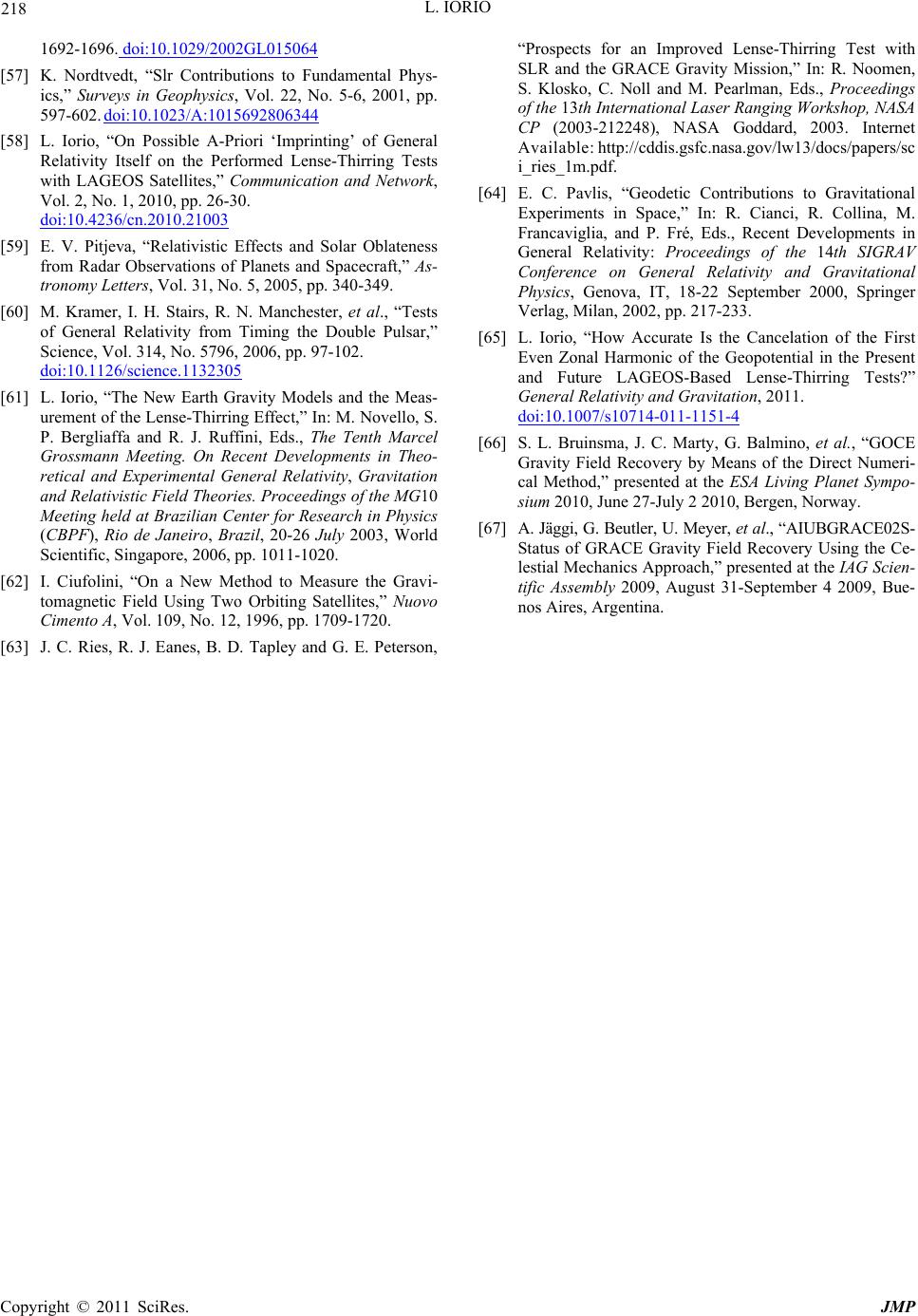 L. IORIO Copyright © 2011 SciRes. JMP 218 1692-1696. doi:10.1029/2002GL015064 [57] K. Nordtvedt, “Slr Contributions to Fundamental Phys- ics,” Surveys in Geophysics, Vol. 22, No. 5-6, 2001, pp. 597-602. doi:10.1023/A:1015692806344 [58] L. Iorio, “On Possible A-Priori ‘Imprinting’ of General Relativity Itself on the Performed Lense-Thirring Tests with LAGEOS Satellites,” Communication and Network, Vol. 2, No. 1, 2010, pp. 26-30. doi:10.4236/cn.2010.21003 [59] E. V. Pitjeva, “Relativistic Effects and Solar Oblateness from Radar Observations of Planets and Spacecraft, 06, pp. 97-102. ” As- tronomy Letters, Vol. 31, No. 5, 2005, pp. 340-349. [60] M. Kramer, I. H. Stairs, R. N. Manchester, et al., “Tests of General Relativity from Timing the Double Pulsar,” Science, Vol. 314, No. 5796, 20 doi:10.1126/science.1132305 arcel he MG ter for Research in Phys men, d P. Fré, Eds., Recent Developments in se-Thirring Tests?” [61] L. Iorio, “The New Earth Gravity Models and the Meas- urement of the Lense-Thirring Effect,” In: M. Novello, S. P. Bergliaffa and R. J. Ruffini, Eds., The Tenth M Gene Grossmann Meeting. On Recent Developments in Theo- retical and Experimental General Relativity, Gravitation and Relativistic Field Theories. Proceedings of t Meeting held at Brazilian Cen 10 ics (CBPF), Rio de Janeiro, Brazil, 20-26 July 2003, World Scientific, Singapore, 2006, pp. 1011-1020. [62] I. Ciufolini, “On a New Method to Measure the Gravi- tomagnetic Field Using Two Orbiting Satellites,” Nuovo Cimento A, Vol. 109, No. 12, 1996, pp. 1709-1720. [63] J. C. Ries, R. J. Eanes, B. D. Tapley and G. E. Peterson, “Prospects for an Improved Lense-Thirring Test with SLR and the GRACE Gravity Mission,” In: R. Noo S. Klosko, C. Noll and M. Pearlman, Eds., Proceedings of the 13th International Laser Ranging Workshop, NASA CP (2003-212248), NASA Goddard, 2003. Internet Available: http://cddis.gsfc.nasa.gov/lw13/docs/papers/sc i_ries_1m.pdf. [64] E. C. Pavlis, “Geodetic Contributions to Gravitational Experiments in Space,” In: R. Cianci, R. Collina, M. Francaviglia, an General Relativity: Proceedings of the 14th SIGRAV Conference on General Relativity and Gravitational Physics, Genova, IT, 18-22 September 2000, Springer Verlag, Milan, 2002, pp. 217-233. [65] L. Iorio, “How Accurate Is the Cancelation of the First Even Zonal Harmonic of the Geopotential in the Present and Future LAGEOS-Based Len ral Relativity and Gravitation, 2011. doi:10.1007/s10714-011-1151-4 [66] S. L. Bruinsma, J. C. Marty, G. Balmino, et al., “GOCE Gravity Field Recovery by Means of the D cal Method,” presented at the ES irect Numeri- A Living Planet Sympo- Scien- sium 2010, June 27-July 2 2010, Bergen, Norway. [67] A. Jäggi, G. Beutler, U. Meyer, et al., “AIUBGRACE02S- Status of GRACE Gravity Field Recovery Using the Ce- lestial Mechanics Approach,” presented at the IAG tific Assembly 2009, August 31-September 4 2009, Bue- nos Aires, Argentina.
|